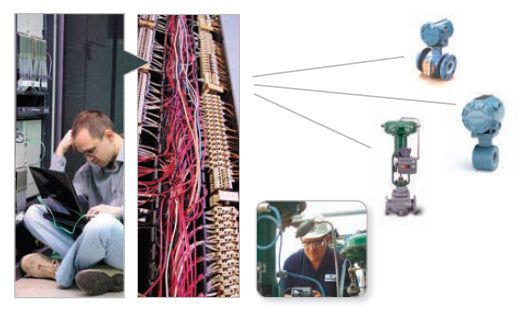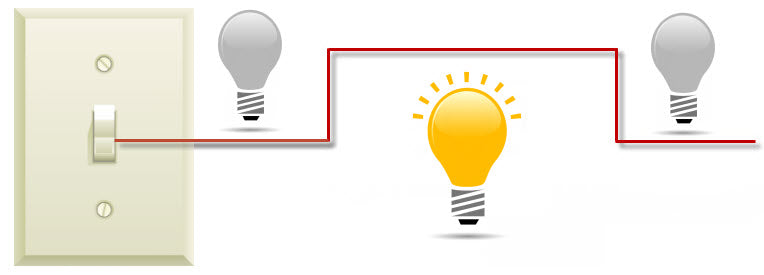Understanding Fieldbus I/O Systems
What is I/O?
In its most basic definition, I/O stands for inputs and outputs. In the industrial automation sector, inputs and outputs relate to pushbuttons, switches, and sensors. For example, a person would create an input signal by pressing a pushbutton. Consequently, a light would turn on and this would be the output signal. As you might imagine, industrial equipment can have hundreds of input and output signals with varying degrees of complexity. A fieldbus I/O system can help group signals from instruments on a machine and monitor and control the entirety of your industrial equipment.
A fieldbus system provides:
- Processor Communication
- Device Communication
- Control and Timing
- Data Buffering
- Error Detection
Traditional Discrete Wiring

The traditional method of connecting field devices to monitoring controls is point-to-point wiring. With discrete wiring you wire field devices to terminal blocks in control panels. This method of I/O wiring is suitable for smaller, less complex equipment. However, larger equipment may have hundreds of I/O points making it a pretty labor-intensive project. Not only that, but it becomes increasingly harder to keep track of which wires go where. Thus, human error increases. The headaches don’t stop there, though. Sometimes there are late I/O changes which can mean rework on drawings, control system partitioning, moving wires, and even building new cabinets.
From Discrete Wiring to Fieldbus I/O Systems
Fieldbus, on the other hand, consists of a series of networked field devices which communicate serially over a 31.25kHz bus. On a fieldbus system, devices can communicate data between each other and the host control system using a single pair of wires. With fieldbus, your data is not limited to a measurement variable, but also includes diagnostics data, status information, and alarms.
If you’re on the fence about incorporating fieldbus into your equipment, consider the following advantages and disadvantages:
Fieldbus I/O Advantages:
Instruments connect to a single trunk cable
Much less cabling
Smaller cabinet footprint
Capability to transmit diagnostic data
Control can be performed in the field devices, lessens the effort of the control system
Measured variable is more accurate as it isn’t converted to a current loop
Fieldbus I/O Disadvantages:
Requires further training
Limitations in intrinsic safety applications
Not commonly accepted for safety systems
Devices require interoperability testing with host system
Extra design effort required (segment calculations, additional configuration data required for control system)
Fieldbus I/O System Options
Fieldbus I/O systems are available with a variety of options which can determine how the I/O system is configured. You can choose from analog and/or digital signals depending on your needs. You’ll also need to determine which industrial network or protocol your fieldbus system will use. Lastly, will you choose to have a distributed I/O system or remote I/O system?
Analog I/O vs. Discrete I/O
First, let’s determine the difference between analog I/O and discrete I/O. Discrete signals, also known as digital signals, only send and receive certain values, such as “on” or “off”. A perfect example of this is a light switch. The light can only either be on or off. If you want to dim the lights, you’ll need an analog signal. Analog signals can send and receive variable signals or detect multiple states.

Digital – Discrete I/O Photo Credit: automationdirect.com

Analog I/O Photo Credit: automationdirect.com
Distributed I/O vs. Remote I/O
Distributed I/O modules are located throughout the machine and data is collected through an industrial network. Multiple processors control different sections of an operation, and the processors share data with each other to coordinate the overall machine operation.
With a remote I/O set up, the control processor is kept at a remote place or at a distance from the other I/O modules. Since data is acquired through an industrial network, the entire machine operation can be monitored off-site. Thus, this type of set up comes in useful when modules are located in hazardous zones.
What are industrial networks?
To connect your devices to a fieldbus system, you’ll need to choose an industrial network protocol to use throughout your system. This network will allow you to collect data from your various equipment. Examples of popular industrials networks include: Profibus, DeviceNet, Modbus, and EtherNet/IP.
Choosing which industrial network is right for you will largely depend on your requirements and specifications. In the Industrial Network Fundamentals video linked below, the speaker goes into the pros and cons of a couple popular networks. Generally, you’ll want to narrow down your choices by asking the following questions:
- What type of topology does the network support?
- How much distance can it go with no repeaters?
- What are the data rates?
- How many nodes does this network support?
- What media does the network use?
- What type of communication does it use?
Gateways
A gateway comes in handy when you want to upgrade or retrofit an existing network. They also allow for communication language or protocol changes. An example of when you might use one is if you’re converting legacy MODBUS RTU/ASCII to MODBUS TCP.
The Future of Fieldbus
The manufacturing industry has seen a huge improvement in data acquisition, equipment monitoring and control since the introduction of fieldbus. Now, we’re seeing a shift into industrial Ethernet devices. Industrial Ethernet boasts faster speeds, greater bandwidth, unlimited node counts, improved diagnostics, easier integration, and the use of standard wireless. Of course, some processes won’t need all the fancy bells and whistle but it’s nice to know the technology exists.
Don’t let the complexity of an I/O system deter you from incorporating them into your machine operations. Fieldbus I/O allows you to collect data, monitor and control machine operations, and saves you valuable installation space. At Trimantec, we carry a variety of distributed I/O modules from Leuze Electronic and Murrelektronik. We hope the information in this blog can help you narrow down your options when shopping for these I/O systems. Please contact us if you have any further questions or comments.
Interested in learning more about industrial Ethernet? Check out these articles we found:
Ethernet vs Fieldbus The Right Network for Your Application
Industrial Ethernet or Fieldbus Network